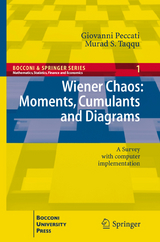Wiener Chaos: Moments, Cumulants and Diagrams
A survey with Computer Implementation
Seiten
The concept of Wiener chaos generalizes to an infinite-dimensional setting the properties of orthogonal polynomials associated with probability distributions on the real line.This book is concerned with combinatorial structures arising from the studyof chaotic random variables related to infinitely divisible random measures.
The concept of Wiener chaos generalizes to an infinite-dimensional setting the
properties of orthogonal polynomials associated with probability distributions
on the real line. It plays a crucial role in modern probability theory, with applications
ranging from Malliavin calculus to stochastic differential equations and from
probabilistic approximations to mathematical finance.
This book is concerned with combinatorial structures arising from the study
of chaotic random variables related to infinitely divisible random measures.
The combinatorial structures involved are those of partitions of finite sets,
over which Möbius functions and related inversion formulae are defined.
This combinatorial standpoint (which is originally due to Rota and Wallstrom)
provides an ideal framework for diagrams, which are graphical devices used
to compute moments and cumulants of random variables.
Several applications are described, in particular, recent limit theorems for chaotic random variables.
An Appendix presents a computer implementation in MATHEMATICA for many of the formulae.
The concept of Wiener chaos generalizes to an infinite-dimensional setting the
properties of orthogonal polynomials associated with probability distributions
on the real line. It plays a crucial role in modern probability theory, with applications
ranging from Malliavin calculus to stochastic differential equations and from
probabilistic approximations to mathematical finance.
This book is concerned with combinatorial structures arising from the study
of chaotic random variables related to infinitely divisible random measures.
The combinatorial structures involved are those of partitions of finite sets,
over which Möbius functions and related inversion formulae are defined.
This combinatorial standpoint (which is originally due to Rota and Wallstrom)
provides an ideal framework for diagrams, which are graphical devices used
to compute moments and cumulants of random variables.
Several applications are described, in particular, recent limit theorems for chaotic random variables.
An Appendix presents a computer implementation in MATHEMATICA for many of the formulae.
Giovanni Peccati is a Professor of Stochastic Analysis and Mathematical Finance at Luxembourg University. Murad S. Taqqu is a Professor of Mathematics and Statistics at Boston University.
| Erscheint lt. Verlag | 28.12.2010 |
|---|---|
| Reihe/Serie | Bocconi & Springer Series ; 1 |
| Zusatzinfo | XIII, 274 p. |
| Verlagsort | Milan |
| Sprache | englisch |
| Maße | 155 x 235 mm |
| Themenwelt | Mathematik / Informatik ► Mathematik ► Analysis |
| Mathematik / Informatik ► Mathematik ► Angewandte Mathematik | |
| Mathematik / Informatik ► Mathematik ► Graphentheorie | |
| Mathematik / Informatik ► Mathematik ► Wahrscheinlichkeit / Kombinatorik | |
| Wirtschaft ► Betriebswirtschaft / Management | |
| ISBN-10 | 88-470-1678-9 / 8847016789 |
| ISBN-13 | 978-88-470-1678-1 / 9788847016781 |
| Zustand | Neuware |
| Informationen gemäß Produktsicherheitsverordnung (GPSR) | |
| Haben Sie eine Frage zum Produkt? |
Mehr entdecken
aus dem Bereich
aus dem Bereich
Buch | Softcover (2024)
De Gruyter Oldenbourg (Verlag)
CHF 83,90
Buch | Softcover (2024)
De Gruyter Oldenbourg (Verlag)
CHF 83,90




